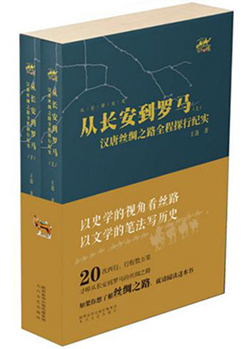
. > WHAT'S NEW > BOOKS
Historical narration of the Silk Road in literary forms
Author : YANG JIANMIN Source : Chinese Social Sciences Today 2018-05-28

From Chang’an to Rome
Author: Wang Peng
Publisher: Taibai Literature and Art Publishing House
Wang Peng’s 40-year literary career can be clearly divided into two phases: The first phase was from 1970 to 1992. In this period he wrote more than ten short stories such as “Critical Meeting” (People’s Literature, 1979 No. 11) and “The Night of Rape Blossoms” (People’s Literature, Issue No. 3, 1981), as well as many works consecutively published in the People’s Daily. These works were either awarded, republished, or triggered commentary, forming the first peak in Wang’s creations. His writing examines the living conditions of peasants living on the lower rungs of society and are full of the rich flavor of life in southern Shaanxi Province. Well-known writer Jia Pingwa said that Wang’s works are “observation full of imagination, ideas focused on artistic conception.”
Since 1992, Wang’s focus has been on history. Influenced by his father who loves both literature and history, Wang’s interest in history mirrors his interest in literature. He spent 10 years crossing the seven passages along the Qinba Mountains to create a comprehensive reflection of the history and culture of these regions in From Chang’an to Sichuan and Yunnan. He then made another 20 visits to the Silk Road and Tangfan Road, and recorded his experiences along the Silk Road in From Chang’an to Rome and From Chang’an to Lhasa with a historical perspective and in literary form. In the two books, Wang revealed the origins of ancient trails and examines these routes from multiple perspectives, interspersing into major historical events and figures, and described a kingdom once brilliant, but disappeared. Wang also wrote wonderful description of geographical phenomena, magnificent landscapes, religious architecture and customs along the ancient roads.
Many ancient roads have different starting dates and different functions. Because of the overwhelming amount of time involved, it is not easy to sort out the major historical events and important figures along the relics and explain that clearly. In addition, though there are many examples of related research, it is regrettable that academic writing is not always easy to read. It only circulates in certain academic circles and it is difficult to make it gain popularity among the broader public.
How, then, does Wang solve these problems? First, Wang was already a mature writer with his own distinctive characteristics when he embarked on the trips to the Silk Road. He originally had a keen interest in history and carefully prepared for the trips. When Wang studied at Peking University, he read Van Loon’s Geography written by the American writer Hendrik van Loon, who used to describe the mountains and rivers, villages and towns, and even a country using literary techniques. Wang was attracted by this technique and successfully applied it to his own writing on the ancient paths. The second reason must be attributed to Wang’s personality: acute, enthusiastic, full of curiosity about new things, and a kind of root-seeking spirit. One major feature of Wang’s historical works is that he described the object as if it was first seen, highlighting the sense of freshness and presence. Also, we see a large number of bibliographies attached to the end of the book. Without reading and studying a great quantity of histoy, it is impossible to tell this complicated story.
(Edited and translated by SUI JINGJING)
Ye Shengtao made Chinese fairy tales from a wilderness
Ye Shengtao (1894–1988) created the first collection of fairy tales in the history of Chinese children’s literature...
-
How northern ethnicities integrated into Chinese nation
2023-09-18
-
Mogao caves
2023-09-12
-
Mogao Grottoes as ‘a place of pilgrimage’
2023-09-12
-
Time-honored architectural traditions in China
2023-08-29
-
Disentangling the civilizational evolution of China
2023-08-28
-
AI ethics in science fiction
2023-08-23













 2011-2013 by www.cssn.cn. All Rights Reserved
2011-2013 by www.cssn.cn. All Rights Reserved